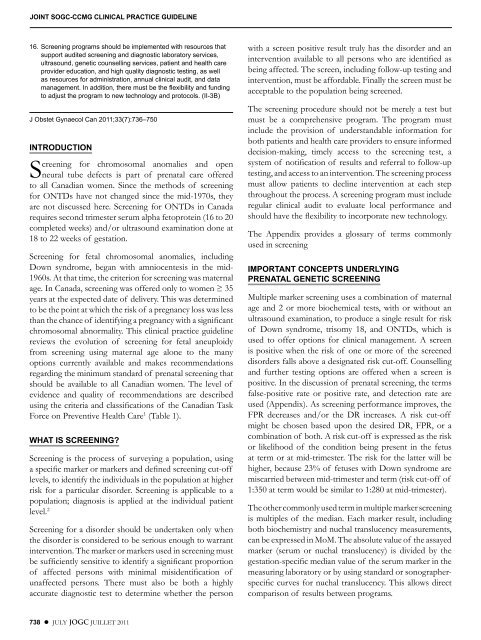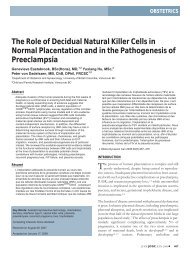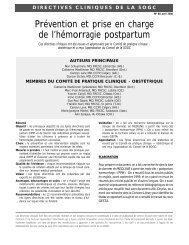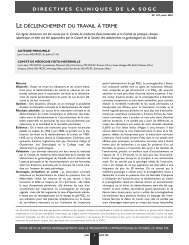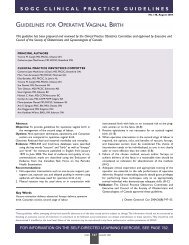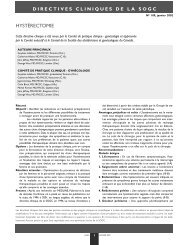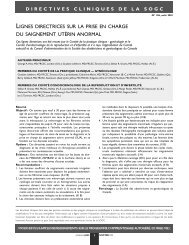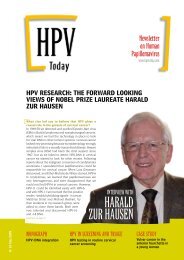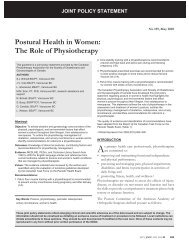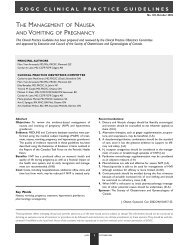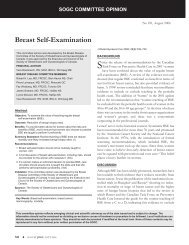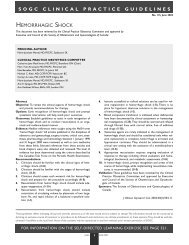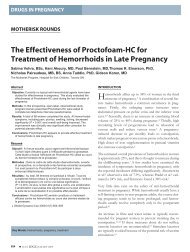Prenatal Screening for Fetal Aneuploidy in Singleton ... - SOGC
Prenatal Screening for Fetal Aneuploidy in Singleton ... - SOGC
Prenatal Screening for Fetal Aneuploidy in Singleton ... - SOGC
You also want an ePaper? Increase the reach of your titles
YUMPU automatically turns print PDFs into web optimized ePapers that Google loves.
JOINT <strong>SOGC</strong>-CCMG CLINICAL PRACTICE GuIDELINE<br />
16 . <strong>Screen<strong>in</strong>g</strong> programs should be implemented with resources that<br />
support audited screen<strong>in</strong>g and diagnostic laboratory services,<br />
ultrasound, genetic counsell<strong>in</strong>g services, patient and health care<br />
provider education, and high quality diagnostic test<strong>in</strong>g, as well<br />
as resources <strong>for</strong> adm<strong>in</strong>istration, annual cl<strong>in</strong>ical audit, and data<br />
management . In addition, there must be the flexibility and fund<strong>in</strong>g<br />
to adjust the program to new technology and protocols . (II-3B)<br />
J Obstet Gynaecol Can 2011;33(7):736–750<br />
INTRODuCTION<br />
<strong>Screen<strong>in</strong>g</strong> <strong>for</strong> chromosomal anomalies and open<br />
neural tube defects is part of prenatal care offered<br />
to all Canadian women. S<strong>in</strong>ce the methods of screen<strong>in</strong>g<br />
<strong>for</strong> ONTDs have not changed s<strong>in</strong>ce the mid-1970s, they<br />
are not discussed here. <strong>Screen<strong>in</strong>g</strong> <strong>for</strong> ONTDs <strong>in</strong> Canada<br />
requires second trimester serum alpha fetoprote<strong>in</strong> (16 to 20<br />
completed weeks) and/or ultrasound exam<strong>in</strong>ation done at<br />
18 to 22 weeks of gestation.<br />
<strong>Screen<strong>in</strong>g</strong> <strong>for</strong> fetal chromosomal anomalies, <strong>in</strong>clud<strong>in</strong>g<br />
Down syndrome, began with amniocentesis <strong>in</strong> the mid-<br />
1960s. At that time, the criterion <strong>for</strong> screen<strong>in</strong>g was maternal<br />
age. In Canada, screen<strong>in</strong>g was offered only to women ≥ 35<br />
years at the expected date of delivery. This was determ<strong>in</strong>ed<br />
to be the po<strong>in</strong>t at which the risk of a pregnancy loss was less<br />
than the chance of identify<strong>in</strong>g a pregnancy with a significant<br />
chromosomal abnormality. This cl<strong>in</strong>ical practice guidel<strong>in</strong>e<br />
reviews the evolution of screen<strong>in</strong>g <strong>for</strong> fetal aneuploidy<br />
from screen<strong>in</strong>g us<strong>in</strong>g maternal age alone to the many<br />
options currently available and makes recommendations<br />
regard<strong>in</strong>g the m<strong>in</strong>imum standard of prenatal screen<strong>in</strong>g that<br />
should be available to all Canadian women. The level of<br />
evidence and quality of recommendations are described<br />
us<strong>in</strong>g the criteria and classifications of the Canadian Task<br />
Force on Preventive Health Care 1 (Table 1).<br />
WHAT IS SCREENING?<br />
<strong>Screen<strong>in</strong>g</strong> is the process of survey<strong>in</strong>g a population, us<strong>in</strong>g<br />
a specific marker or markers and def<strong>in</strong>ed screen<strong>in</strong>g cut-off<br />
levels, to identify the <strong>in</strong>dividuals <strong>in</strong> the population at higher<br />
risk <strong>for</strong> a particular disorder. <strong>Screen<strong>in</strong>g</strong> is applicable to a<br />
population; diagnosis is applied at the <strong>in</strong>dividual patient<br />
level. 2<br />
<strong>Screen<strong>in</strong>g</strong> <strong>for</strong> a disorder should be undertaken only when<br />
the disorder is considered to be serious enough to warrant<br />
<strong>in</strong>tervention. The marker or markers used <strong>in</strong> screen<strong>in</strong>g must<br />
be sufficiently sensitive to identify a significant proportion<br />
of affected persons with m<strong>in</strong>imal misidentification of<br />
unaffected persons. There must also be both a highly<br />
accurate diagnostic test to determ<strong>in</strong>e whether the person<br />
738 l JULY JOGC JUILLET 2011<br />
with a screen positive result truly has the disorder and an<br />
<strong>in</strong>tervention available to all persons who are identified as<br />
be<strong>in</strong>g affected. The screen, <strong>in</strong>clud<strong>in</strong>g follow-up test<strong>in</strong>g and<br />
<strong>in</strong>tervention, must be af<strong>for</strong>dable. F<strong>in</strong>ally the screen must be<br />
acceptable to the population be<strong>in</strong>g screened.<br />
The screen<strong>in</strong>g procedure should not be merely a test but<br />
must be a comprehensive program. The program must<br />
<strong>in</strong>clude the provision of understandable <strong>in</strong><strong>for</strong>mation <strong>for</strong><br />
both patients and health care providers to ensure <strong>in</strong><strong>for</strong>med<br />
decision-mak<strong>in</strong>g, timely access to the screen<strong>in</strong>g test, a<br />
system of notification of results and referral to follow-up<br />
test<strong>in</strong>g, and access to an <strong>in</strong>tervention. The screen<strong>in</strong>g process<br />
must allow patients to decl<strong>in</strong>e <strong>in</strong>tervention at each step<br />
throughout the process. A screen<strong>in</strong>g program must <strong>in</strong>clude<br />
regular cl<strong>in</strong>ical audit to evaluate local per<strong>for</strong>mance and<br />
should have the flexibility to <strong>in</strong>corporate new technology.<br />
The Appendix provides a glossary of terms commonly<br />
used <strong>in</strong> screen<strong>in</strong>g<br />
IMPORTANT CONCEPTS uNDERLYING<br />
PRENATAL GENETIC SCREENING<br />
Multiple marker screen<strong>in</strong>g uses a comb<strong>in</strong>ation of maternal<br />
age and 2 or more biochemical tests, with or without an<br />
ultrasound exam<strong>in</strong>ation, to produce a s<strong>in</strong>gle result <strong>for</strong> risk<br />
of Down syndrome, trisomy 18, and ONTDs, which is<br />
used to offer options <strong>for</strong> cl<strong>in</strong>ical management. A screen<br />
is positive when the risk of one or more of the screened<br />
disorders falls above a designated risk cut-off. Counsell<strong>in</strong>g<br />
and further test<strong>in</strong>g options are offered when a screen is<br />
positive. In the discussion of prenatal screen<strong>in</strong>g, the terms<br />
false-positive rate or positive rate, and detection rate are<br />
used (Appendix). As screen<strong>in</strong>g per<strong>for</strong>mance improves, the<br />
FPR decreases and/or the DR <strong>in</strong>creases. A risk cut-off<br />
might be chosen based upon the desired DR, FPR, or a<br />
comb<strong>in</strong>ation of both. A risk cut-off is expressed as the risk<br />
or likelihood of the condition be<strong>in</strong>g present <strong>in</strong> the fetus<br />
at term or at mid-trimester. The risk <strong>for</strong> the latter will be<br />
higher, because 23% of fetuses with Down syndrome are<br />
miscarried between mid-trimester and term (risk cut-off of<br />
1:350 at term would be similar to 1:280 at mid-trimester).<br />
The other commonly used term <strong>in</strong> multiple marker screen<strong>in</strong>g<br />
is multiples of the median. Each marker result, <strong>in</strong>clud<strong>in</strong>g<br />
both biochemistry and nuchal translucency measurements,<br />
can be expressed <strong>in</strong> MoM. The absolute value of the assayed<br />
marker (serum or nuchal translucency) is divided by the<br />
gestation-specific median value of the serum marker <strong>in</strong> the<br />
measur<strong>in</strong>g laboratory or by us<strong>in</strong>g standard or sonographerspecific<br />
curves <strong>for</strong> nuchal translucency. This allows direct<br />
comparison of results between programs.


